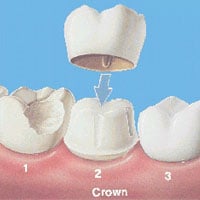
Crowns
A crown is a cap for your tooth. It is needed when there is quite significant damage to your tooth. For example, it may be missing a portion, be severely worn down, broken or generally lacking structural support. When that’s the case, a normal filling won’t be enough. As with inlays, a crown will be customised to fit you and will be shaped in a laboratory. Similarly, the process will take place over two appointments. On the first appointment, Dr St George will do the following:
- Prepare the tooth
- Take impressions of the tooth shape
- Place a temporary crown
The impressions will go to the laboratory where they will shape a new tooth which sits over your eroded tooth like a cap. On your second appointment:
- The permanent crown will be bonded to your tooth
What type of crown?
Traditionally crowns were made of gold. While that has some merits, many people now prefer to opt for a natural looking porcelain crown. Of these options, it’s possible to have porcelain fused to metal. The metal does add some durability and strength. However, over time, a receding gum line can reveal the metal. A gold crown or porcelain fused with metal option may be worthwhile if the patient tends to grind or clench the teeth, or just has a very strong bite. In many cases, however, an all-ceramic crown will suit. The appearance will be natural and blend with the other teeth. The thinner material is suitable for smaller spaces than the traditional metal. Dr St George will talk through your options to find the best solution for you.






